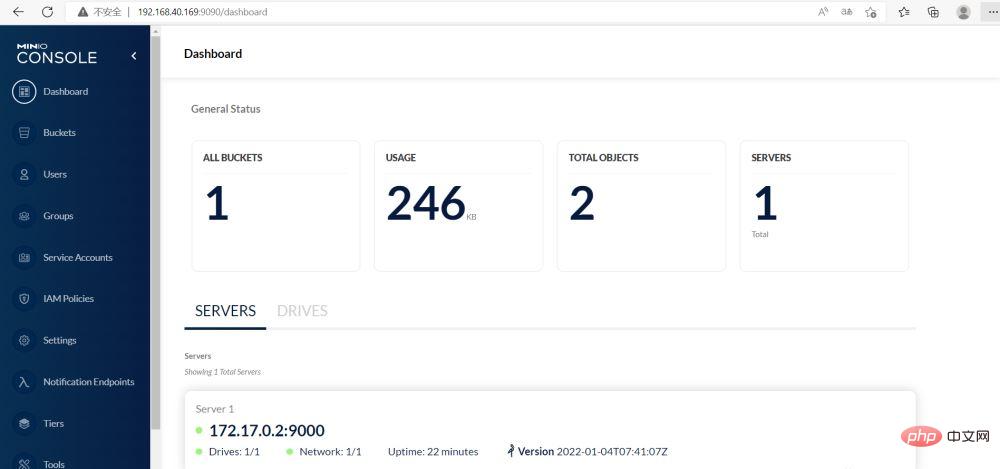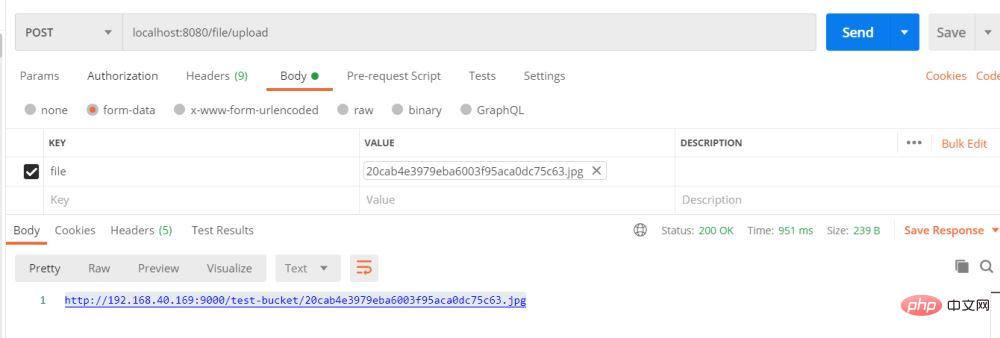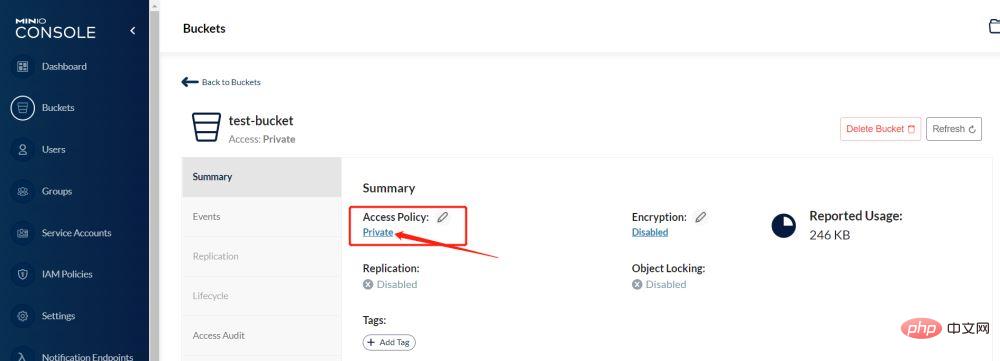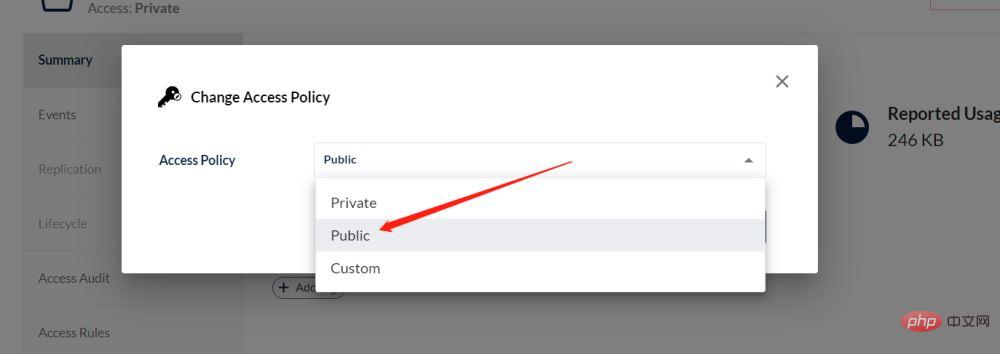SpringBoot怎麼使用Minio進行文件存儲
- WBOYWBOYWBOYWBOYWBOYWBOYWBOYWBOYWBOYWBOYWBOYWBOYWB轉載
- 2023-05-11 12:16:052034瀏覽
一、minio
MinIO 是一個高效能的物件儲存原生支援 Kubernetes 部署的解決方案。 MinIO 提供了一個 Amazon Web Services S3 相容 API 並支援所有核心 S3 功能。
MinIO 物件儲存使用 buckets 來組織物件。儲存桶類似於檔案系統中的資料夾或目錄,其中每個 桶可以容納任意數量的物件。 MinIO 儲存桶提供 與 AWS S3 儲存桶相同的功能。
其中MinIO 的優點有:
高效能:
MinIO是全球領先的物件儲存先鋒,在標準硬體上,讀取/寫入速度高達183 GB / 秒 和171 GB / 秒。
可擴充性:
MinIO利用了web縮放器的來之不易的知識,為物件存儲帶來了簡單的存儲縮放模型, 在MinIO, 擴展從單一群集開始,該群集可以與其他MinIO群集聯合以創建全域名稱空間, 並在需要時可以跨越多個不同的資料中心。透過增加更多叢集可以擴展名稱空間, 更多機架,直到實現目標。
雲端原生支援:
MinIO 是過去4年的時間內從0開始打造的軟體,符合一切原生雲運算的架構和建置過程,並且包含最新的雲端運算的全新的技術和概念。其中包括支援Kubernetes 、微服和多租戶的容器技術。使物件儲存對於 Kubernetes更加友善。
原始碼開放與企業級支援:
MinIO 基於Apache V2 license 100% 開放原始碼 。這意味著MinIO的客戶能夠自動的、無限制、自由免費使用和整合MinIO、自由的創新和創造、 自由的去修改、自由的再次發行新的版本和軟體. 確實, MinIO 強有力的支持和驅動了很多世界500強的企業。此外,其部署的多樣性和專業性提供了其他軟體無法比擬的優勢。
在實驗開始前請確保安裝完成了minio :

#二、SpringBoot 使用Minio 進行檔案儲存
#先新建一個SpringBoot 項目,在pom 中引入minio 依賴:
<dependency>
<groupId>io.minio</groupId>
<artifactId>minio</artifactId>
<version>8.2.1</version>
</dependency>在設定檔中,宣告出 minio 的資訊:
minio: url: http://192.168.40.169:9000 # minio配置的地址,端口9000,注意不是控制台的端口 accessKey: minioadmin # 账号 secretKey: minioadmin # 密码 bucketName: test-bucket # MinIO桶名字
下方建立一個設定類,並對MinioClient 進行建立:
@Data
@Configuration
@ConfigurationProperties(prefix = "minio")
public class MinioConfig {
/**
* 服务地址
*/
private String url;
/**
* 用户名
*/
private String accessKey;
/**
* 密码
*/
private String secretKey;
/**
* 存储桶名称
*/
private String bucketName;
@Bean
public MinioClient getMinioClient() throws Exception {
MinioClient minioClient = MinioClient.builder().endpoint(url).credentials(accessKey, secretKey).build();
//判断桶是否存在,不存在则新建
if (!minioClient.bucketExists(BucketExistsArgs.builder().bucket(bucketName).build())){
minioClient.makeBucket(MakeBucketArgs.builder()
.bucket(bucketName)
.build());
}
return minioClient;
}
}下方建立一個工具類別MinioTool將常用的操作封裝在工具類別中:
@Component
public class MinioTool {
@Autowired
private MinioClient minioClient;
@Autowired
private MinioConfig minioConfig;
/**
* 查看存储bucket是否存在
*
* @param bucketName 存储bucket
* @return boolean
*/
public Boolean bucketExists(String bucketName) {
Boolean found;
try {
found = minioClient.bucketExists(BucketExistsArgs.builder().bucket(bucketName).build());
} catch (Exception e) {
e.printStackTrace();
return false;
}
return found;
}
/**
* 创建存储bucket
*
* @param bucketName 存储bucket名称
* @return Boolean
*/
public Boolean makeBucket(String bucketName) {
try {
minioClient.makeBucket(MakeBucketArgs.builder()
.bucket(bucketName)
.build());
} catch (Exception e) {
e.printStackTrace();
return false;
}
return true;
}
/**
* 删除存储bucket
*
* @param bucketName 存储bucket名称
* @return Boolean
*/
public Boolean removeBucket(String bucketName) {
try {
minioClient.removeBucket(RemoveBucketArgs.builder()
.bucket(bucketName)
.build());
} catch (Exception e) {
e.printStackTrace();
return false;
}
return true;
}
/**
* 查看文件对象
*
* @param bucketName 存储bucket名称
* @return 存储bucket内文件对象信息
*/
public Iterable<Result<Item>> listObjects(String bucketName) {
Iterable<Result<Item>> results = minioClient.listObjects(
ListObjectsArgs.builder().bucket(bucketName).build());
return results;
}
/**
* 批量删除文件对象
*
* @param bucketName 存储bucket名称
* @param objects 对象名称集合
*/
public Iterable<Result<DeleteError>> removeObjects(String bucketName, List<String> objects) {
List<DeleteObject> dos = objects.stream().map(e -> new DeleteObject(e)).collect(Collectors.toList());
Iterable<Result<DeleteError>> results = minioClient.removeObjects(RemoveObjectsArgs.builder().bucket(bucketName).objects(dos).build());
return results;
}
/**
* 文件上传
* 文件名称相同会覆盖
* @param file 文件
* @return Boolean
*/
public Boolean upload(MultipartFile file, String fileName) {
try {
if (!bucketExists(minioConfig.getBucketName())) {
makeBucket(minioConfig.getBucketName());
}
PutObjectArgs objectArgs = PutObjectArgs.builder().bucket(minioConfig.getBucketName()).object(fileName)
.stream(file.getInputStream(), file.getSize(), -1).contentType(file.getContentType()).build();
minioClient.putObject(objectArgs);
} catch (Exception e) {
e.printStackTrace();
return false;
}
return true;
}
/**
* 文件下载
*
* @param fileName 文件名称
* @param res response
* @return Boolean
*/
public void download(String fileName, HttpServletResponse res) {
GetObjectArgs objectArgs = GetObjectArgs.builder().bucket(minioConfig.getBucketName())
.object(fileName).build();
try (GetObjectResponse response = minioClient.getObject(objectArgs)) {
byte[] buf = new byte[1024];
int len;
try (FastByteArrayOutputStream os = new FastByteArrayOutputStream()) {
while ((len = response.read(buf)) != -1) {
os.write(buf, 0, len);
}
os.flush();
byte[] bytes = os.toByteArray();
res.setCharacterEncoding("utf-8");
//设置强制下载不打开
res.setContentType("application/force-download");
res.addHeader("Content-Disposition", "attachment;fileName=" + fileName);
try (ServletOutputStream stream = res.getOutputStream()) {
stream.write(bytes);
stream.flush();
}
}
} catch (Exception e) {
e.printStackTrace();
}
}
public String getFileUrl(String fileName){
return StringFormatter.concat(minioConfig.getUrl(), "/", minioConfig.getBucketName(), "/", fileName).getValue();
}
}編寫測試接口,進行測試:
@Component
public class MinioTool {
@Autowired
private MinioClient minioClient;
@Autowired
private MinioConfig minioConfig;
/**
* 查看存储bucket是否存在
*
* @param bucketName 存储bucket
* @return boolean
*/
public Boolean bucketExists(String bucketName) {
Boolean found;
try {
found = minioClient.bucketExists(BucketExistsArgs.builder().bucket(bucketName).build());
} catch (Exception e) {
e.printStackTrace();
return false;
}
return found;
}
/**
* 创建存储bucket
*
* @param bucketName 存储bucket名称
* @return Boolean
*/
public Boolean makeBucket(String bucketName) {
try {
minioClient.makeBucket(MakeBucketArgs.builder()
.bucket(bucketName)
.build());
} catch (Exception e) {
e.printStackTrace();
return false;
}
return true;
}
/**
* 删除存储bucket
*
* @param bucketName 存储bucket名称
* @return Boolean
*/
public Boolean removeBucket(String bucketName) {
try {
minioClient.removeBucket(RemoveBucketArgs.builder()
.bucket(bucketName)
.build());
} catch (Exception e) {
e.printStackTrace();
return false;
}
return true;
}
/**
* 查看文件对象
*
* @param bucketName 存储bucket名称
* @return 存储bucket内文件对象信息
*/
public Iterable<Result<Item>> listObjects(String bucketName) {
Iterable<Result<Item>> results = minioClient.listObjects(
ListObjectsArgs.builder().bucket(bucketName).build());
return results;
}
/**
* 批量删除文件对象
*
* @param bucketName 存储bucket名称
* @param objects 对象名称集合
*/
public Iterable<Result<DeleteError>> removeObjects(String bucketName, List<String> objects) {
List<DeleteObject> dos = objects.stream().map(e -> new DeleteObject(e)).collect(Collectors.toList());
Iterable<Result<DeleteError>> results = minioClient.removeObjects(RemoveObjectsArgs.builder().bucket(bucketName).objects(dos).build());
return results;
}
/**
* 文件上传
* 文件名称相同会覆盖
* @param file 文件
* @return Boolean
*/
public Boolean upload(MultipartFile file, String fileName) {
try {
if (!bucketExists(minioConfig.getBucketName())) {
makeBucket(minioConfig.getBucketName());
}
PutObjectArgs objectArgs = PutObjectArgs.builder().bucket(minioConfig.getBucketName()).object(fileName)
.stream(file.getInputStream(), file.getSize(), -1).contentType(file.getContentType()).build();
minioClient.putObject(objectArgs);
} catch (Exception e) {
e.printStackTrace();
return false;
}
return true;
}
/**
* 文件下载
*
* @param fileName 文件名称
* @param res response
* @return Boolean
*/
public void download(String fileName, HttpServletResponse res) {
GetObjectArgs objectArgs = GetObjectArgs.builder().bucket(minioConfig.getBucketName())
.object(fileName).build();
try (GetObjectResponse response = minioClient.getObject(objectArgs)) {
byte[] buf = new byte[1024];
int len;
try (FastByteArrayOutputStream os = new FastByteArrayOutputStream()) {
while ((len = response.read(buf)) != -1) {
os.write(buf, 0, len);
}
os.flush();
byte[] bytes = os.toByteArray();
res.setCharacterEncoding("utf-8");
//设置强制下载不打开
res.setContentType("application/force-download");
res.addHeader("Content-Disposition", "attachment;fileName=" + fileName);
try (ServletOutputStream stream = res.getOutputStream()) {
stream.write(bytes);
stream.flush();
}
}
} catch (Exception e) {
e.printStackTrace();
}
}
public String getFileUrl(String fileName){
return StringFormatter.concat(minioConfig.getUrl(), "/", minioConfig.getBucketName(), "/", fileName).getValue();
}
}三、測試
##測試上傳檔案:

Bucket的Access Policy ,預設為private,可以修改為public 便無需認證,但安全性無法保證:




private ,可以透過MinioClient 進行下載,使用download 測試介面下載檔:http://localhost:8080/file/download/20cab4e3979eba6003f95aca0dc75c63 .jpg

以上是SpringBoot怎麼使用Minio進行文件存儲的詳細內容。更多資訊請關注PHP中文網其他相關文章!

